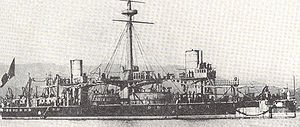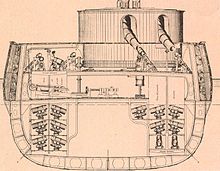- Italian ironclad Caio Duilio
-
For other ships of the same name, see Italian ship Caio Duilio.

Career 
Name: Caio Duilio Namesake: Gaius Duilius Laid down: 24 April 1873 Launched: 8 May 1876 Commissioned: 6 January 1880 Decommissioned: 1906 Fate: Scrapped, 1909 General characteristics Type: Ironclad battleship Displacement: 11,138 long tons (11,317 t)
12,267 long tons (12,464 t) fullLength: 109.2 m (358 ft 3 in) Beam: 19.79 m (64 ft 11 in) Draught: 8.8 m (28 ft 10 in) Propulsion: 8 coal-fired boilers, two double-expansion steam engines Speed: 15 knots (28 km/h; 17 mph) at 7,710 hp (5,749 kW) Range: 3,760 nmi (6,960 km) at economical speed Complement: 420 Armament: • 2 × 2 450 mm (17.7 in) muzzle-loading guns
• 22 × 37 mm (1.5 in)
• 3 × 120 mm (4.7 in)
• 2 × 75 mm (3 in)
• 8 × 57 mm (2.2 in)
• 3 × torpedo tubesArmour: Waterline belt: 550 mm (22 in)
Turrets: 450 mm (18 in)
Citadel: 400 mm (16 in)Caio Duilio was the lead ship in a class of two ironclad battleships built in Italy for the Regia Marina in the 1870s. A revolutionary design fitted with the largest guns available, 100-ton 450 mm calibre muzzle-loading guns, she and her sister ship were regarded as the most powerful warships afloat in their day.
On March 1873, Italian minister of the navy Admiral Simone Arturo Saint-Bon announced the construction of three new battleships for the Regia Marina, which would be the most powerful in the world. The naval architect Benedetto Brin was asked to design them. The first to be launched was Caio Duilio, named after the Roman Consul Gaius Duilius. Constructing these ships greatly stretched the infant Italian ship industry but, at the same time, helped the country to develop towards a modern industrial economy. Only two ships were constructed.
Contents
Design
In her day the Caio Duilio was as revolutionary in her design as the French La Gloire had been a decade before. The ship exemplified the concept of the 'monster gun', a vessel carrying the heaviest calibre weapons possible, capable of incapacitating an enemy warship with a single hit.
Initially designed to carry four 38-ton rifled muzzle loaders, similar to those carried on the British HMS Devastation the design was sufficiently flexible to permit the gun calibre to be increased during construction. When the British armaments manufacturer Armstrongs announced their 50-ton 355 mm RML (rifled muzzle loader), Duilio was modified to receive it instead, which required considerable modifications to the ship's armour to save the necessary weight. Eventually the gun calibre was increased to accept an even newer and larger Armstrong gun, the 100-ton 450 mm RML.
To accommodate such massive weapons, the armour belt was restricted to the central third of the vessel, forming a citadel on which the turrets were mounted en-echelon (forward turret to starboard). This arrangement enabled all guns to bear on either beam, but end-on fire was compromised by the severity of the muzzle blast causing damage to the ship's unarmoured upperworks.
Either end of the ship, outside the citadel, was subdivided into watertight compartments, so that flooding due to damage to the ends would be contained, and would be insufficient to compromise stability.
Weight of armour and armament precluded auxiliary sail propulsion, which for the limited range required to operate in the Mediterranean, was in any case unnecessary. The ship was a mastless design. The design speed of 15 knots was high for a battleship of this era, but there was insufficient space within the citadel to accommodate all the machinery. The boilers and engine spaces were protected by an armoured deck 50 mm thick extending the full length of the waterline. This protection scheme was described as a 'raft-body' design.
The compromises in protection, and general structural weakness, raise doubts as to whether the large guns could keep firing across the deck. The unarmoured ends were vulnerable to rapid firing light weapons, and could conceivably flood sufficiently to cause her to turn turtle without penetrating the thick armour at all.
These perceived limitations were probably overstated for ships designed to operate in the sheltered waters of the Mediterranean.
Accident
In 1880 a gun of the Duilio fractured due use of very coarse prismatic powder (Fossano powder more precisely) which subjected the gun to pressure irregularities. Thereafter charges were reduced in the Italian Navy, and the British followed suit.[1]
British response
The ship was widely regarded as the most powerful of her day, inspiring the Royal Navy, the largest in the world at the time, to respond with HMS Inflexible, intended as a direct counter to the Caio Duilio and her sister ship Enrico Dandolo. The Royal Navy perceived the growing Regia Marina as a potential threat both to its territories and bases in the Mediterranean and to its trade route through the Suez Canal to India. Inflexible was conceptually very similar to the Italian ships, and attracted the same controversy. However, Inflexible was originally designed with 60-ton guns, to outgun the Italian ships' original 35-ton guns.
However it was not possible to increase the size of the British ship's guns to keep up with those of the Italian ships; and Inflexible was completed with 81-ton 16 inch (406 mm) guns. As a further measure, however, the British government installed two of Armstrong's 100-ton 450 mm guns in Gibraltar and another two in Malta. One gun of each of these pairs has survived to the present. In Gibraltar the British mounted one gun in Victoria Battery (1879) and the other in Napier of Magdala Battery (1883); the gun in Malta is at Fort Rinella.
References
External links
- Page at Italian Navy official website (Italian)[dead link]
See also
 Media related to Italian ironclad Caio Duilio at Wikimedia CommonsCategories:
Media related to Italian ironclad Caio Duilio at Wikimedia CommonsCategories:- Duilio class battleships
- Ships built in Italy
- 1876 ships
Wikimedia Foundation. 2010.


